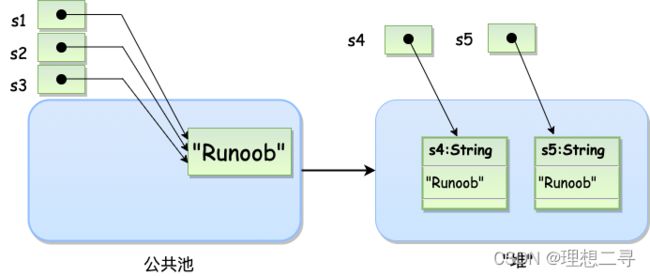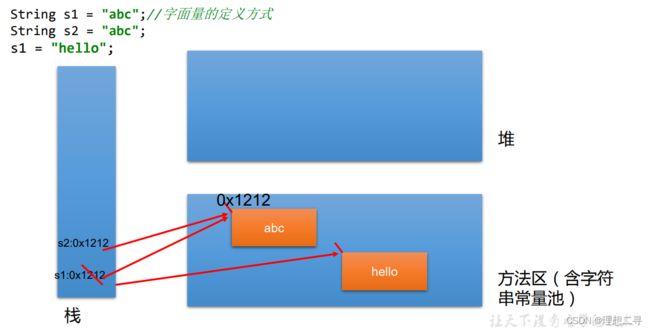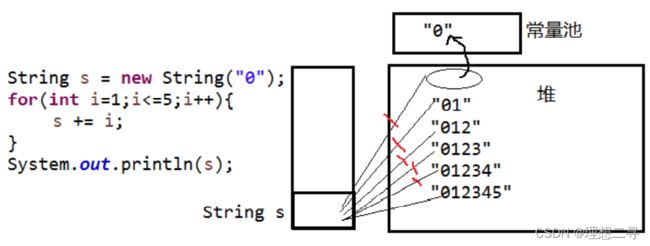字符串相关的类
目录
String类:
String的特性:
字符串的创建方式:
创建字符串最简单的方式如下:
用构造函数创建字符串:
常量池:
对象中的字符串是怎么储存的:
String使用陷阱:
String常用方法:
练习1:
练习二:
练习三:
String相关算法题与面试题:
StringBuffer与StringBuilder:
StringBuffer:
联系
面试题:对比String、StringBuffer、StringBuilder
注意:
面试题:
引用:
String类:
String的特性:
- String类:代表字符串。Java 程序中的所有字符串字面值(如 "abc" )都作为此类的实例实现。
- String是一个final类,代表不可继承。
- 字符串是常量,用双引号引起来表示。String的值在创建之后不能更改。
- String对象的字符内容是存储在一个字符数组value[]中的。注意char数组是final的,不可更改
- 不可更改体现:如果字符串初始化后,再次赋值,会重新new一个Sting,变相用一个不同的char数组来存储新的值
public final class Stringimplements java.io.Serializable, Comparable, CharSequence {
/** The value is used for character storage. */
private final char value[];
/** Cache the hash code for the string */
private int hash; // Default to 0字符串的创建方式:
创建字符串最简单的方式如下:
String str = "Runoob";
在代码中遇到字符串常量时,这里的值是 "Runoob",编译器会使用该值创建一个 String 对象。
和其它对象一样,可以使用关键字和构造方法来创建 String 对象。
用构造函数创建字符串:
String str2=new String("Runoob");
String 创建的字符串存储在公共池中,而 new 创建的字符串对象在堆上:
String s1 = "Runoob"; // String 直接创建
String s2 = "Runoob"; // String 直接创建
String s3 = s1; // 相同引用
String s4 = new String("Runoob"); // String 对象创建
String s5 = new String("Runoob"); // String 对象创建常量池:
字符串用等号赋值时,会在常量池中生成(编译时就已经确定)。此时存在方法区中。
比如上图
- String s1 = "abc"; 将s1指向方法区常量池的"abc"常量
- String s2 = "abc"; 将s2指向方法区常量池的"abc"常量(同一个常量)
- s1 = "hello"; 此时字符串用等号赋值发生了改变,s1不在指向“abc”,而是指向另一个常量
对象中的字符串是怎么储存的:
class Person {
String name;
int age;
public Person(String name, int age) {
this.name = name;
this.age = age;
}
}
public class Main {
public static void main(String[] args) {
Person p1 = new Person("Tom",18);
Person p2 = new Person("Tom",18);
System.out.println(p1==p2);//false
System.out.println(p1.name == p2.name);//true;
}
}String使用陷阱:
String s1 = "a";
说明:在字符串常量池中创建了一个字面量为"a"的字符串。
s1 = s1 + "b";
说明:s1是变量,只有全是常量的赋值,才会在存储常量池中。实际上原来的“a”字符串对象已经丢弃了,现在在堆空间中产生了一个字符串s1+"b"(也就是"ab")。如果多次执行这些改变串内容的操作,会导致大量副本字符串对象存留在内存中,降低效率。如果这样的操作放到循环中,会极大影响程序的性能。
String s2 = "ab";
说明:直接在字符串常量池中创建一个字面量为"ab"的字符串。
String s3 = "a" + "b";
说明:s3指向字符串常量池中已经创建的"ab"的字符串。
String s4 = s1.intern();
说明:堆空间的s1对象在调用intern()之后,会将常量池中已经存在的"ab"字符串赋值给s4。
String常用方法:
| SN(序号) |
方法描述 |
| 1 |
char charAt(int index) 返回指定索引处的 char 值。 |
| 2 |
int compareTo(Object o) 把这个字符串和另一个对象比较。 |
| 3 |
int compareTo(String anotherString) 按字典顺序比较两个字符串。 |
| 4 |
int compareToIgnoreCase(String str) 按字典顺序比较两个字符串,不考虑大小写。 |
| 5 |
String concat(String str) 将指定字符串连接到此字符串的结尾。 |
| 6 |
boolean contentEquals(StringBuffer sb) 当且仅当字符串与指定的StringBuffer有相同顺序的字符时候返回真。 |
| 7 |
static String copyValueOf(char[] data) 返回指定数组中表示该字符序列的 String。 |
| 8 |
static String copyValueOf(char[] data, int offset, int count) 返回指定数组中表示该字符序列的 String。 |
| 9 |
boolean endsWith(String suffix) 测试此字符串是否以指定的后缀结束。 |
| 10 |
boolean equals(Object anObject) 将此字符串与指定的对象比较。 |
| 11 |
boolean equalsIgnoreCase(String anotherString) 将此 String 与另一个 String 比较,不考虑大小写。 |
| 12 |
byte[] getBytes() 使用平台的默认字符集将此 String 编码为 byte 序列,并将结果存储到一个新的 byte 数组中。 |
| 13 |
byte[] getBytes(String charsetName) 使用指定的字符集将此 String 编码为 byte 序列,并将结果存储到一个新的 byte 数组中。 |
| 14 |
void getChars(int srcBegin, int srcEnd, char[] dst, int dstBegin) 将字符从此字符串复制到目标字符数组。 |
| 15 |
int hashCode() 返回此字符串的哈希码。 |
| 16 |
int indexOf(int ch) 返回指定字符在此字符串中第一次出现处的索引。 |
| 17 |
int indexOf(int ch, int fromIndex) 返回在此字符串中第一次出现指定字符处的索引,从指定的索引开始搜索。 |
| 18 |
int indexOf(String str) 返回指定子字符串在此字符串中第一次出现处的索引。 |
| 19 |
int indexOf(String str, int fromIndex) 返回指定子字符串在此字符串中第一次出现处的索引,从指定的索引开始。 |
| 20 |
String intern() 返回字符串对象的规范化表示形式。 |
| 21 |
int lastIndexOf(int ch) 返回指定字符在此字符串中最后一次出现处的索引。 |
| 22 |
int lastIndexOf(int ch, int fromIndex) 返回指定字符在此字符串中最后一次出现处的索引,从指定的索引处开始进行反向搜索。 |
| 23 |
int lastIndexOf(String str) 返回指定子字符串在此字符串中最右边出现处的索引。 |
| 24 |
int lastIndexOf(String str, int fromIndex) 返回指定子字符串在此字符串中最后一次出现处的索引,从指定的索引开始反向搜索。 |
| 25 |
int length() 返回此字符串的长度。 |
| 26 |
boolean matches(String regex) 告知此字符串是否匹配给定的正则表达式。 |
| 27 |
boolean regionMatches(boolean ignoreCase, int toffset, String other, int ooffset, int len) 测试两个字符串区域是否相等。 |
| 28 |
boolean regionMatches(int toffset, String other, int ooffset, int len) 测试两个字符串区域是否相等。 |
| 29 |
String replace(char oldChar, char newChar) 返回一个新的字符串,它是通过用 newChar 替换此字符串中出现的所有 oldChar 得到的。 |
| 30 |
String replaceAll(String regex, String replacement) 使用给定的 replacement 替换此字符串所有匹配给定的正则表达式的子字符串。 |
| 31 |
String replaceFirst(String regex, String replacement) 使用给定的 replacement 替换此字符串匹配给定的正则表达式的第一个子字符串。 |
| 32 |
String[] split(String regex) 根据给定正则表达式的匹配拆分此字符串。 |
| 33 |
String[] split(String regex, int limit) 根据匹配给定的正则表达式来拆分此字符串。 |
| 34 |
boolean startsWith(String prefix) 测试此字符串是否以指定的前缀开始。 |
| 35 |
boolean startsWith(String prefix, int toffset) 测试此字符串从指定索引开始的子字符串是否以指定前缀开始。 |
| 36 |
CharSequence subSequence(int beginIndex, int endIndex) 返回一个新的字符序列,它是此序列的一个子序列。 |
| 37 |
String substring(int beginIndex) 返回一个新的字符串,它是此字符串的一个子字符串。 |
| 38 |
String substring(int beginIndex, int endIndex) 返回一个新字符串,它是此字符串的一个子字符串。 |
| 39 |
char[] toCharArray() 将此字符串转换为一个新的字符数组。 |
| 40 |
String toLowerCase() 使用默认语言环境的规则将此 String 中的所有字符都转换为小写。 |
| 41 |
String toLowerCase(Locale locale) 使用给定 Locale 的规则将此 String 中的所有字符都转换为小写。 |
| 42 |
String toString() 返回此对象本身(它已经是一个字符串!)。 |
| 43 |
String toUpperCase() 使用默认语言环境的规则将此 String 中的所有字符都转换为大写。 |
| 44 |
String toUpperCase(Locale locale) 使用给定 Locale 的规则将此 String 中的所有字符都转换为大写。 |
| 45 |
String trim() 返回字符串的副本,忽略前导空白和尾部空白。 |
| 46 |
static String valueOf(primitive data type x) 返回给定data type类型x参数的字符串表示形式。 |
| 47 |
contains(CharSequence chars) 判断是否包含指定的字符系列。 |
| 48 |
isEmpty() 判断字符串是否为空。 |
练习1:
String str = "12hello34world5java7891mysql456";
//把字符串中的数字替换成,,如果结果中开头和结尾有,的话去掉
String string = str.replaceAll("\\d+", ",").replaceAll("^,|,$", "");
System.out.println(string);正则表达式
练习二:
String str = "12345";
//判断str字符串中是否全部有数字组成,即有1-n个数字组成
boolean matches = str.matches("\\d+");
System.out.println(matches);
String tel = "0571-4534289";
//判断这是否是一个杭州的固定电话
boolean result = tel.matches("0571-\\d{7,8}");
System.out.println(result);练习三:
String str = "中";
System.out.println(str.getBytes("ISO8859-1").length);// -128~127
System.out.println(str.getBytes("GBK").length);
System.out.println(str.getBytes("UTF-8").length);
System.out.println(new String(str.getBytes("ISO8859-1"), "ISO8859-1"));// 乱码,表示不了中文
System.out.println(new String(str.getBytes("GBK"), "GBK"));
System.out.println(new String(str.getBytes("UTF-8"), "UTF-8"));String相关算法题与面试题:
String经典算法题与面试题
StringBuffer与StringBuilder:
StringBuffer:
特点:
- java.lang.StringBuffer代表可变的字符序列,JDK1.0中声明,可以对字符串内容进行增删,此时不会产生新的对象。
- 很多方法与String相同。
- 作为参数传递时,方法内部可以改变值。
abstract class AbstractstringBuilder implements Appendable,charSequence {
/*The value is used for character storage.*/
char[ ] value;//value没有final声明,value可以不断扩容。
/*The count is the number of characters used.*/
int count;//count记录有效字符的个数。构造:
StringBuffer类不同于String,其对象必须使用构造器生成。有三个构造器:
-
- StringBuffer():初始容量为16的字符串缓冲区
- StringBuffer(int size):构造指定容量的字符串缓冲区
- StringBuffer(String str):将内容初始化为指定字符串内容
String s = new String("我喜欢学习"); StringBuffer buffer = new StringBuffer("我喜欢学习"); buffer.append("数学");、
常用方法:
StringBuffer append(xxx):提供了很多的append()方法,用于进行字符串拼接
StringBuffer delete(int start,int end):删除指定位置的内容
StringBuffer replace(int start, int end, String str):把[start,end)位置替换为str
StringBuffer insert(int offset, xxx):在指定位置插入xxxStringBuffer reverse() :把当前字符序列逆转
public int indexOf(String str)
public String substring(int start,int end)
public int length()
public char charAt(int n )
public void setCharAt(int n ,char ch)
StringBuilder:
联系
StringBuilder 和 StringBuffer 非常类似,均代表可变的字符序列,而且提供相关功能的方法也一样
面试题:对比String、StringBuffer、StringBuilder
String(JDK1.0):不可变字符序列
StringBuffer(JDK1.0):可变字符序列、效率低、线程安全
StringBuilder(JDK 5.0):可变字符序列、效率高、线程不安全
注意:
作为参数传递的话,方法内部String不会改变其值,StringBuffer和StringBuilder会改变其值。
面试题:
String str = null; StringBuffer sb = new StringBuffer(); sb.append(str); System.out.println(sb.length());// System.out.println(sb);// StringBuffer sb1 = new StringBuffer(str); System.out.println(sb1);//
append方法有保护机制,先判断是不是null,如果是则append("null")
具体参考这篇csdn博客
String str = null; System.out.println("null"+" "+str);
变量相加也会创建一个StringBuilder对象,调用append方法。所以输出
null null
引用:
菜鸟教程:
Java String 类 | 菜鸟教程 (runoob.com)
csdn博主andyonlines的博客:(13条消息) 2. 关于StringBuffer 创建对象和append函数传入null对象的情况_andyonlines的博客-CSDN博客





